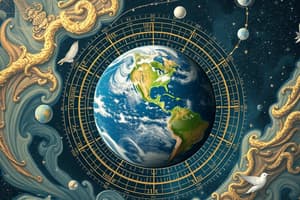Podcast
Questions and Answers
What causes seasons to change?
What causes seasons to change?
The tilt of Earth's axis causes seasons to change.
The first day of fall in the Northern Hemisphere is indicated by the _________.
The first day of fall in the Northern Hemisphere is indicated by the _________.
September Equinox
The Earth takes 365.25 days to do what?
The Earth takes 365.25 days to do what?
Revolve around the Sun
Where is Earth's northern axis pointing on the first day of winter?
Where is Earth's northern axis pointing on the first day of winter?
Why is Earth colder at the poles than at the equator?
Why is Earth colder at the poles than at the equator?
What causes days and nights on Earth?
What causes days and nights on Earth?
What is an equator?
What is an equator?
What is an equinox?
What is an equinox?
What is an orbit?
What is an orbit?
What is revolution?
What is revolution?
What is rotation?
What is rotation?
What is a rotation axis?
What is a rotation axis?
What is a solstice?
What is a solstice?
What are maria?
What are maria?
What is a phase?
What is a phase?
What is a waning phase?
What is a waning phase?
What is a waxing phase?
What is a waxing phase?
What is a lunar eclipse?
What is a lunar eclipse?
What is penumbra?
What is penumbra?
What is a solar eclipse?
What is a solar eclipse?
What is a tide?
What is a tide?
What is umbra?
What is umbra?
Sun's energy reaches Earth as _______ and _______.
Sun's energy reaches Earth as _______ and _______.
How long does it take Earth to make one revolution around the Sun?
How long does it take Earth to make one revolution around the Sun?
What force keeps the Earth revolving around the Sun?
What force keeps the Earth revolving around the Sun?
Rotation is a _______ motion.
Rotation is a _______ motion.
One complete Earth rotation is called a _______ and takes _______ hours.
One complete Earth rotation is called a _______ and takes _______ hours.
Earth's rotation axis is always _______ in the same direction by the same amount.
Earth's rotation axis is always _______ in the same direction by the same amount.
Earth's rotation makes objects in the sky appear to move from _______ to _______.
Earth's rotation makes objects in the sky appear to move from _______ to _______.
The energy in a beam of sunlight is spread out more at the _______ than at the _______.
The energy in a beam of sunlight is spread out more at the _______ than at the _______.
Earth rotates in a (clockwise/______) direction.
Earth rotates in a (clockwise/______) direction.
If the gravity between Earth and the Sun somehow stopped, what would happen to Earth?
If the gravity between Earth and the Sun somehow stopped, what would happen to Earth?
Around what does the Earth revolve?
Around what does the Earth revolve?
Where does the north end of Earth's rotation axis lean during the December Solstice?
Where does the north end of Earth's rotation axis lean during the December Solstice?
Which season does the December Solstice mark in the Northern Hemisphere?
Which season does the December Solstice mark in the Northern Hemisphere?
Which season does the December Solstice mark in the Southern Hemisphere?
Which season does the December Solstice mark in the Southern Hemisphere?
Why are the temperatures cooler in the Northern Hemisphere during the time near the December Solstice?
Why are the temperatures cooler in the Northern Hemisphere during the time near the December Solstice?
What is true about the number of daylight hours during the March Equinox?
What is true about the number of daylight hours during the March Equinox?
Which season does the March Equinox mark in the Northern Hemisphere?
Which season does the March Equinox mark in the Northern Hemisphere?
Flashcards are hidden until you start studying
Study Notes
Seasons and Earth's Movements
- Seasons change due to the tilt of Earth's axis relative to its orbit around the Sun.
- The September Equinox marks the first day of fall in the Northern Hemisphere.
- Earth completes one revolution around the Sun in 365.25 days, which defines a year.
Earth's Rotation
- On the first day of winter, Earth's northern axis points away from the Sun.
- Days and nights are caused by Earth's rotation, which takes approximately 24 hours to complete one full turn.
- The equator is the imaginary line dividing Earth into northern and southern hemispheres.
Equinoxes and Solstices
- An equinox occurs when Earth's axis is not tilted toward or away from the Sun, resulting in nearly equal day and night.
- A solstice is the day when Earth's rotation axis is at its maximum tilt toward or away from the Sun, indicating the start of summer or winter.
Moon Features and Phases
- Maria are large, dark, flat areas on the Moon's surface.
- The phases of the Moon refer to the illuminated portion visible from Earth, with waxing phases indicating increasing visibility and waning phases indicating decreasing visibility.
Eclipses
- A lunar eclipse happens when the Moon enters Earth's shadow, while a solar eclipse occurs when the Moon casts its shadow on Earth.
- The penumbra is the lighter, outer part of a shadow where partial light is blocked; the umbra is the central, darker part where light is completely blocked.
Tides and Energy
- Tides are caused by the daily rise and fall of sea level influenced by the gravitational pull of the Moon and Sun.
- Sun's energy reaches Earth primarily in the form of light and thermal energy, more concentrated at the equator than at the poles.
Earth's Stability and Directionality
- The Sun's gravity is the force that keeps Earth in orbit around it; if this force ceased, Earth would move in a straight line away from the Sun.
- Earth rotates counterclockwise, so celestial objects appear to move from east to west in the sky.
Seasonal Variations and Daylight
- During the December Solstice, the northern axis leans away from the Sun, marking winter in the Northern Hemisphere and summer in the Southern Hemisphere.
- Near the December Solstice, temperatures are cooler in the Northern Hemisphere due to reduced sunlight.
- The March Equinox results in nearly equal hours of daylight and darkness worldwide; it marks the start of spring in the Northern Hemisphere and autumn in the Southern Hemisphere.
Studying That Suits You
Use AI to generate personalized quizzes and flashcards to suit your learning preferences.




